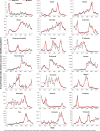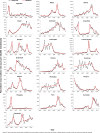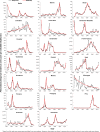Malaria in the Americas: trends from 1959 to 2011
- PMID: 25548378
- PMCID: PMC4347333
- DOI: 10.4269/ajtmh.14-0368
Malaria in the Americas: trends from 1959 to 2011
Abstract
Malaria has declined in recent years in countries of the American continents. In 2011, 12 of 21 endemic countries had already met their 2015 Millennium Development Goal. However, this declining trend has not been adequately evaluated. An analysis of the number of cases per 100,000 people (annual parasite index [API]) and the percentage of positive blood slides (slide positivity rate [SPR]) during the period of 1959-2011 in 21 endemic countries was done using the joinpoint regression methodology. During 1960-1979, API and SPR increased significantly and peaked in the 1980s. Since the 1990s, there have been significant declining trends in both API and SPR. Additionally, both Plasmodium vivax and P. falciparum species-specific incidence have declined. With the exception of two countries, such a collectively declining malaria trend was not observed in previous decades. This presents a unique opportunity for the Americas to seriously consider malaria elimination as a final goal.
© The American Society of Tropical Medicine and Hygiene.
Figures





References
-
- Pan American Health Organization . Pro Salute Novi Mundi: A History of the Pan American Health Organization. Washington, DC: PAHO; 1992.
-
- World Health Organization . World Malaria Report: 2012. Geneva: WHO Press; 2012.
-
- World Health Organization . Global Malaria Control and Elimination: Report of a Technical Review. Geneva: World Health Organization; 2008. p. 54.
Publication types
MeSH terms
Grants and funding
LinkOut - more resources
Full Text Sources
Other Literature Sources
Medical
Miscellaneous

